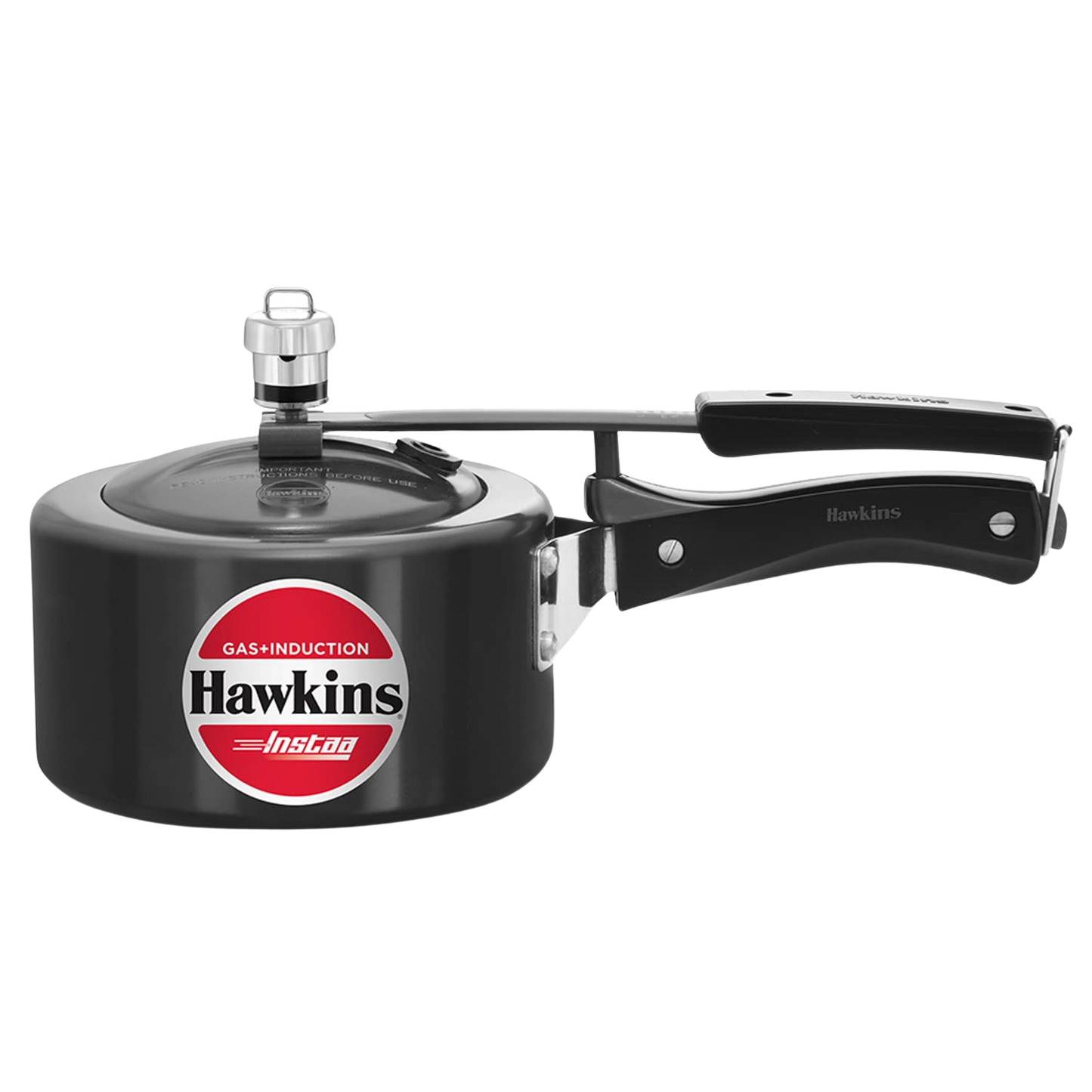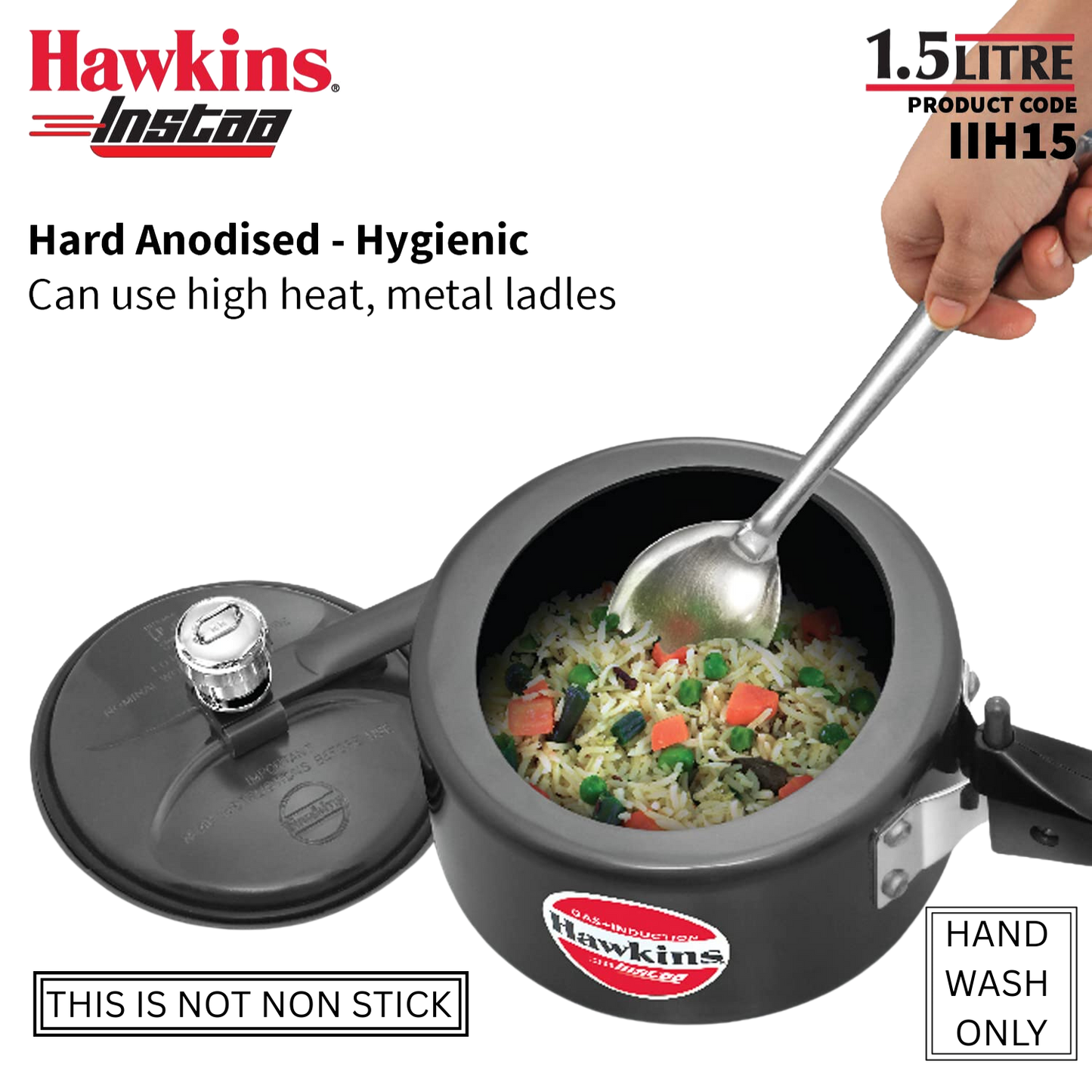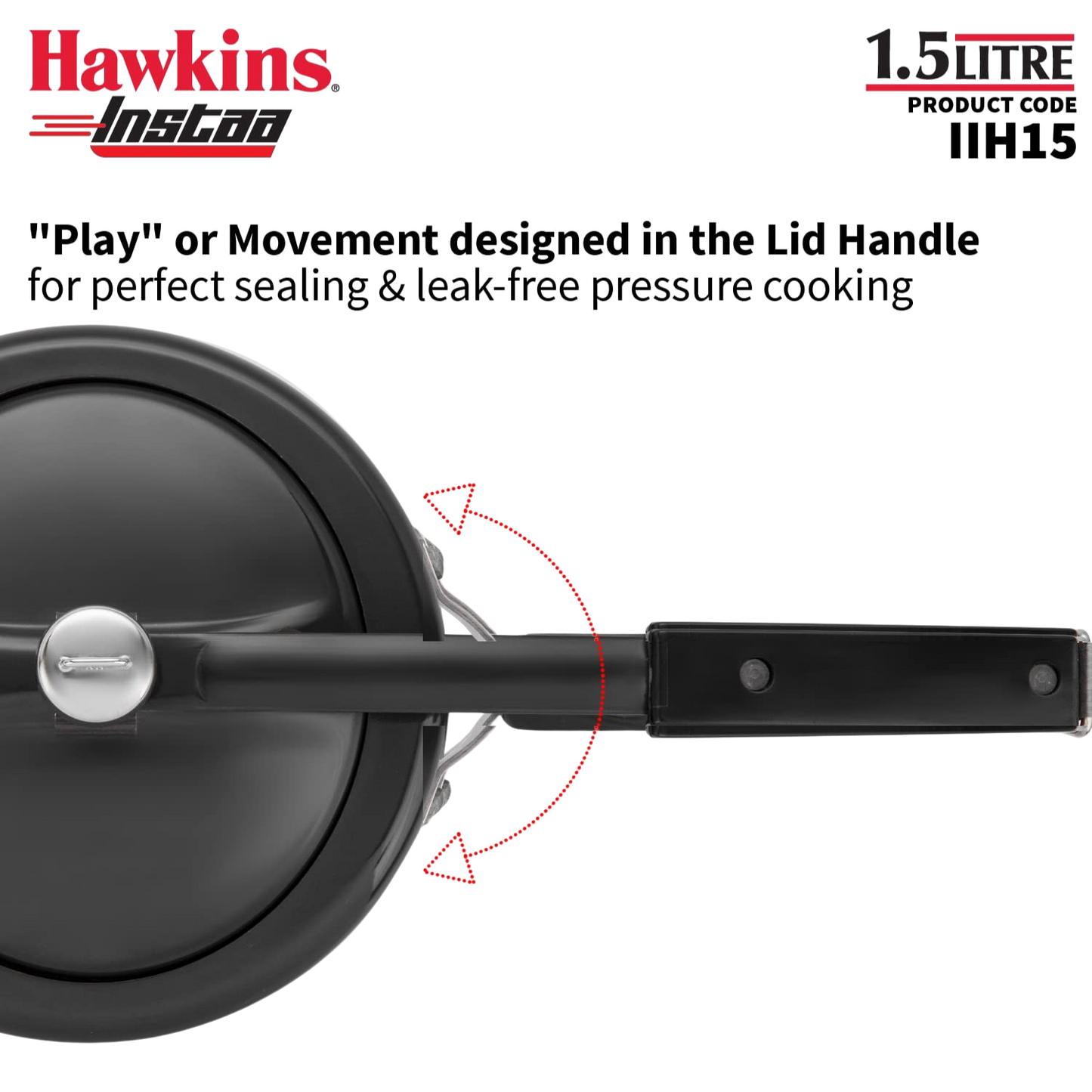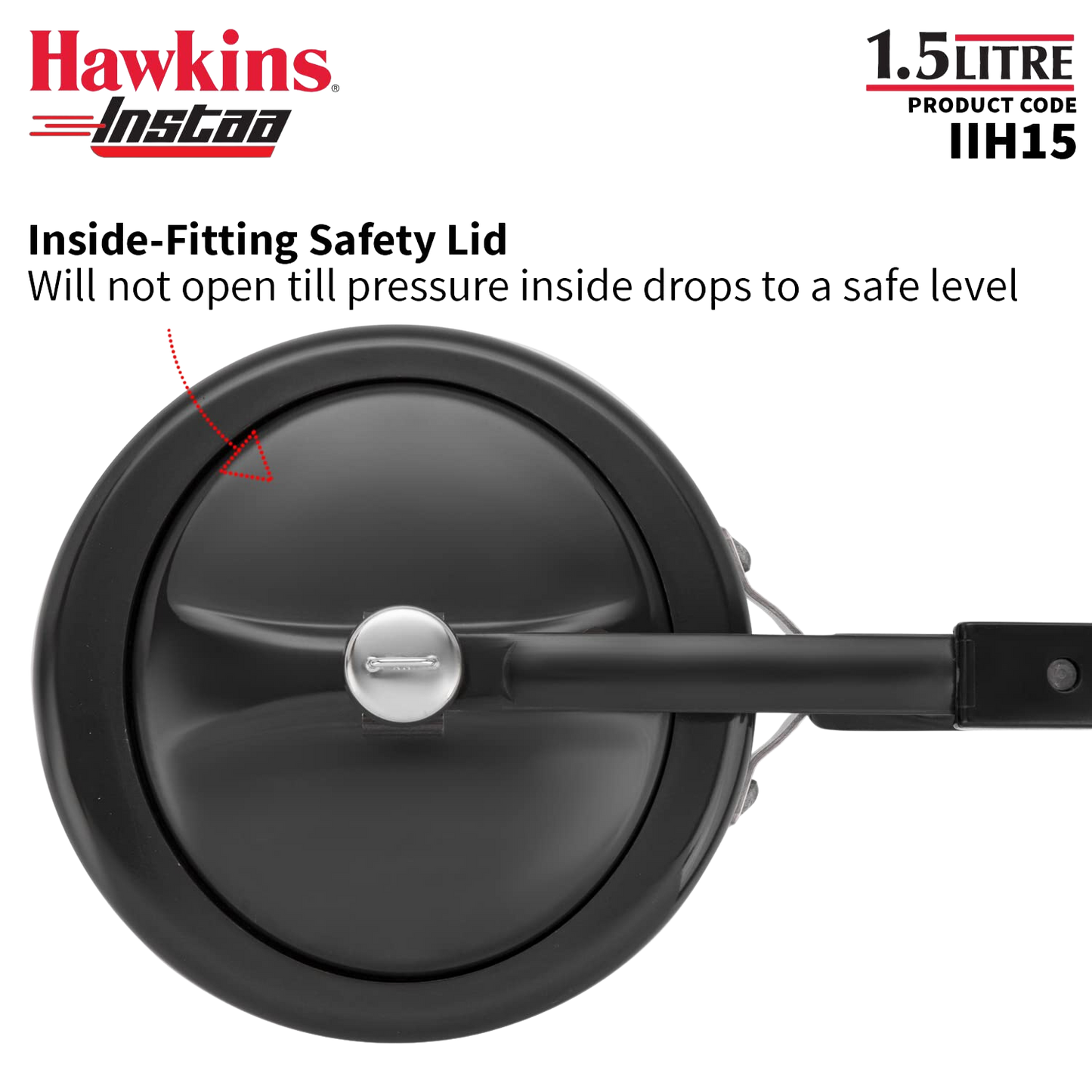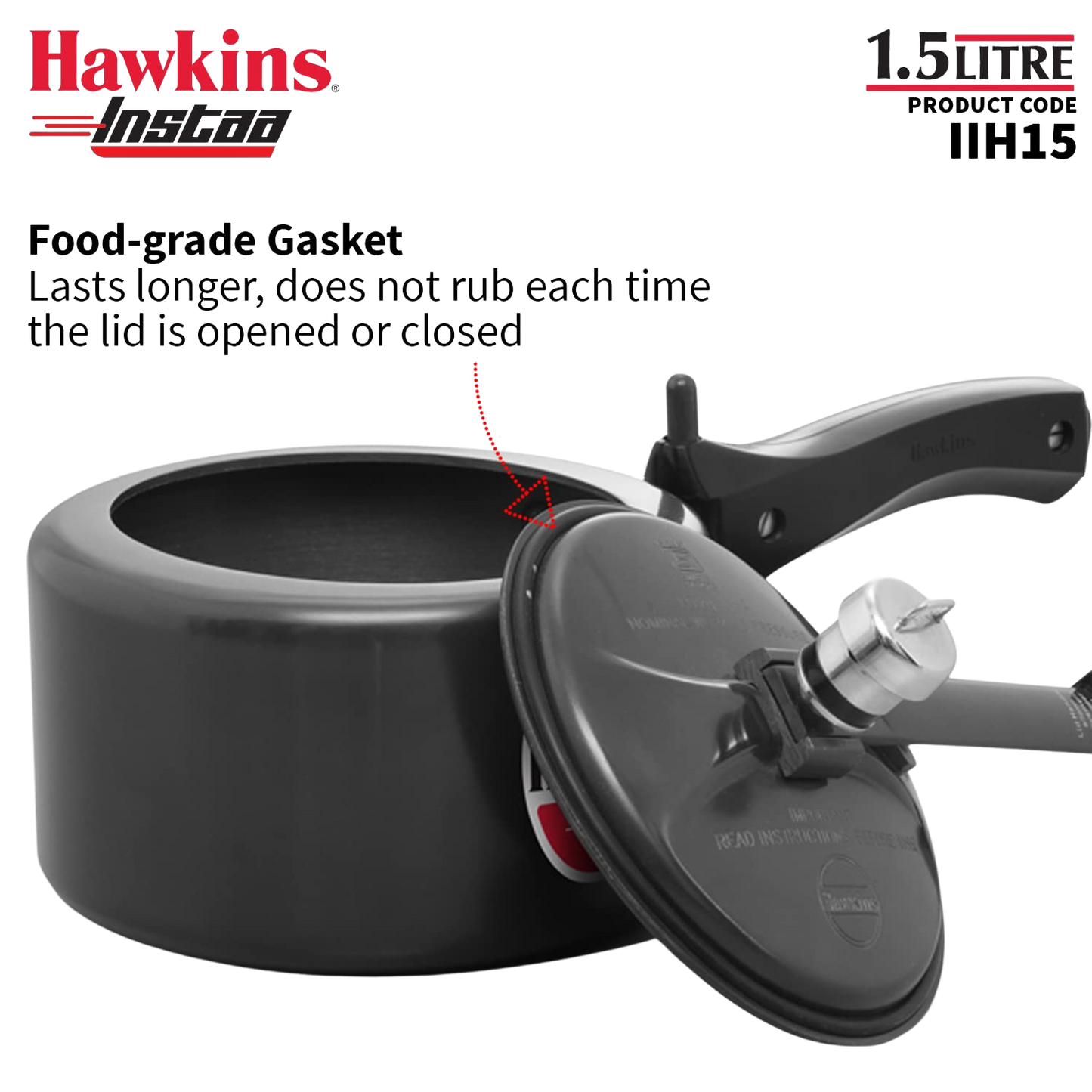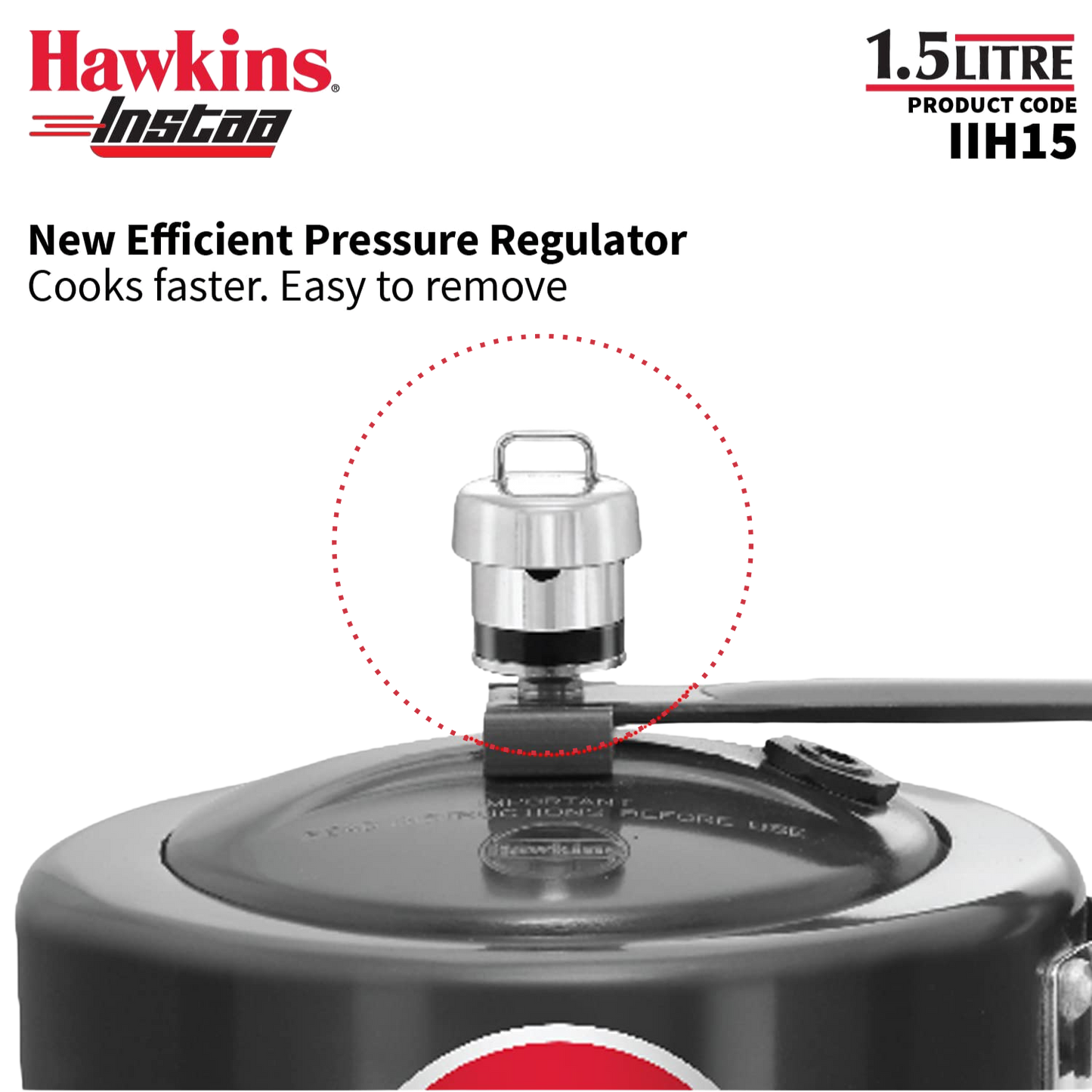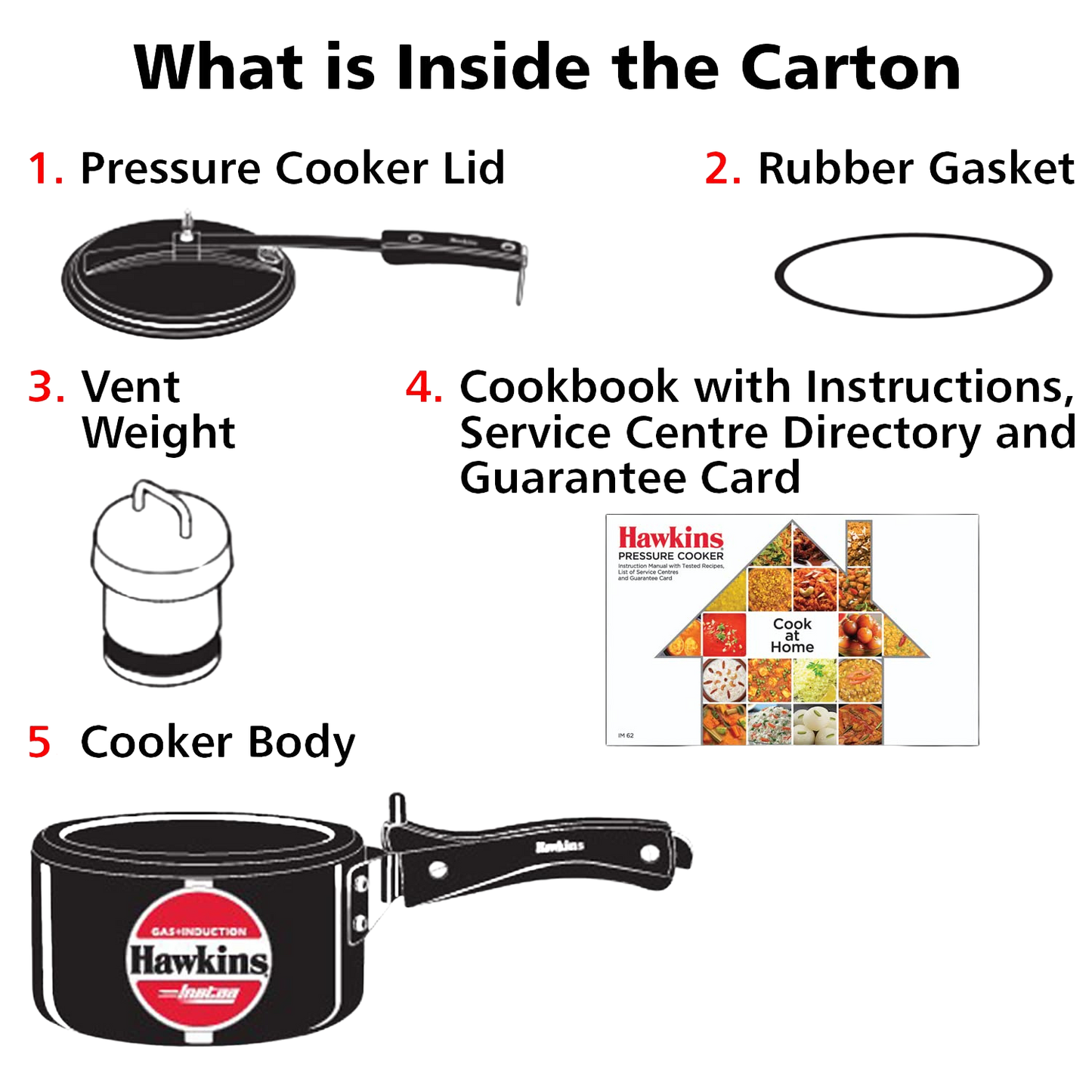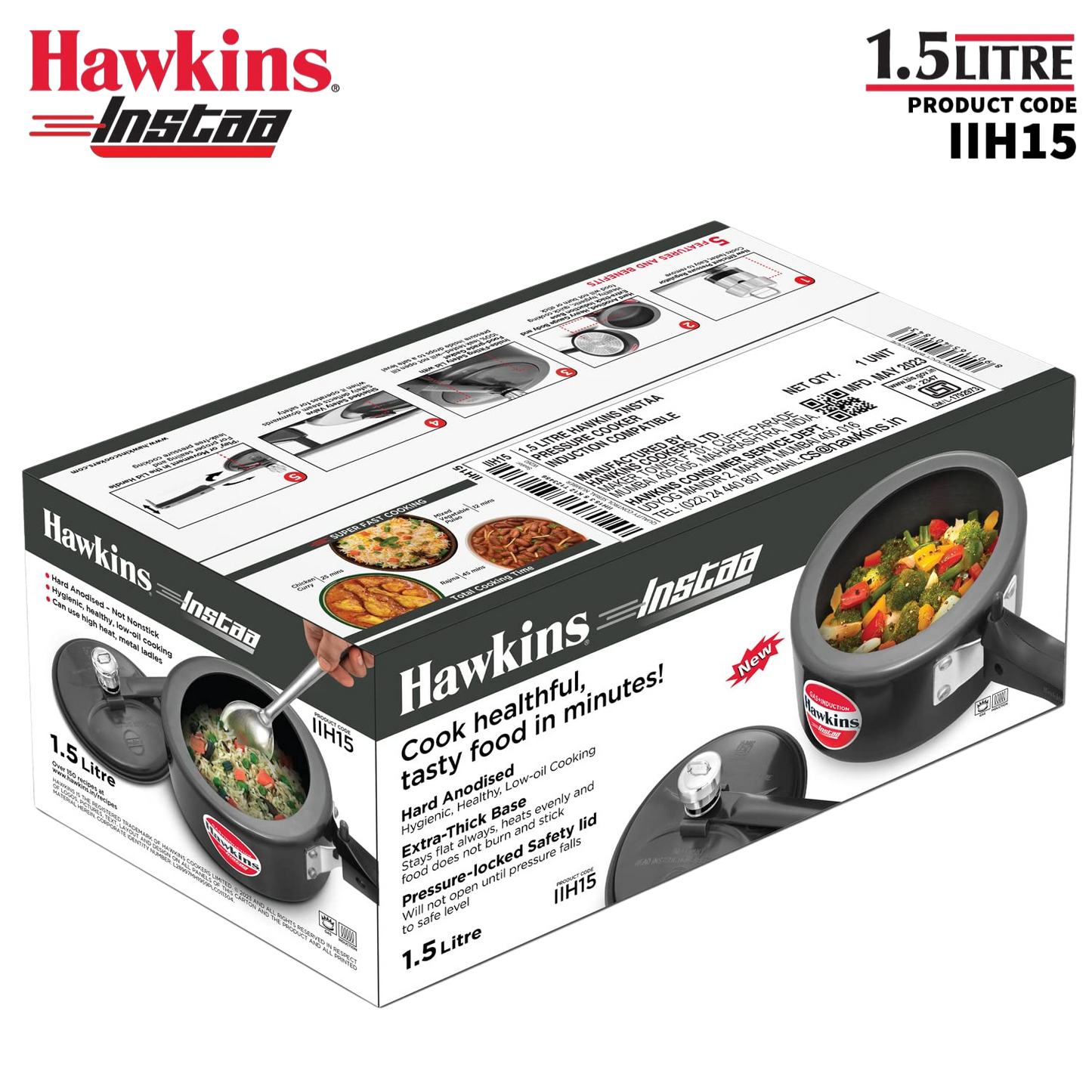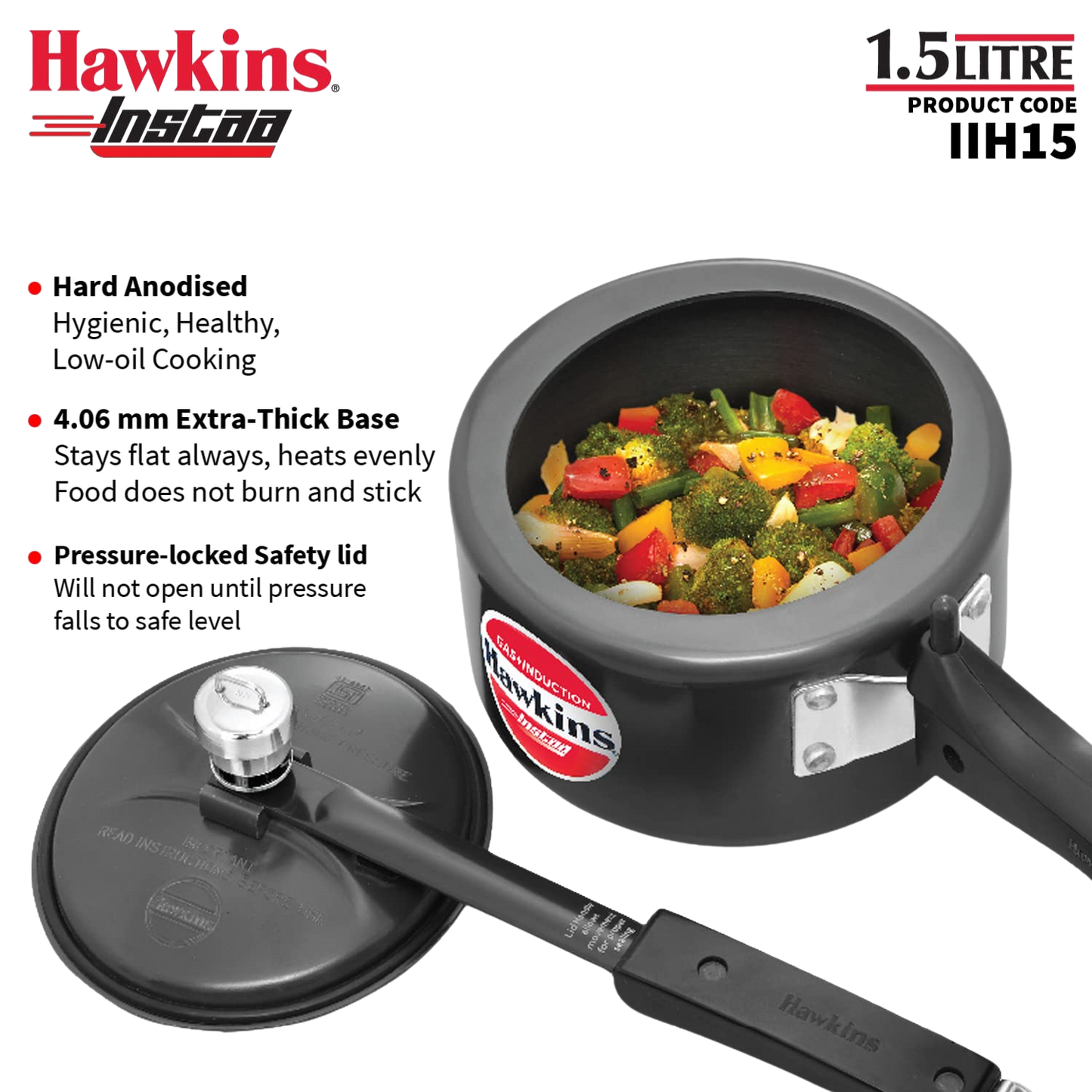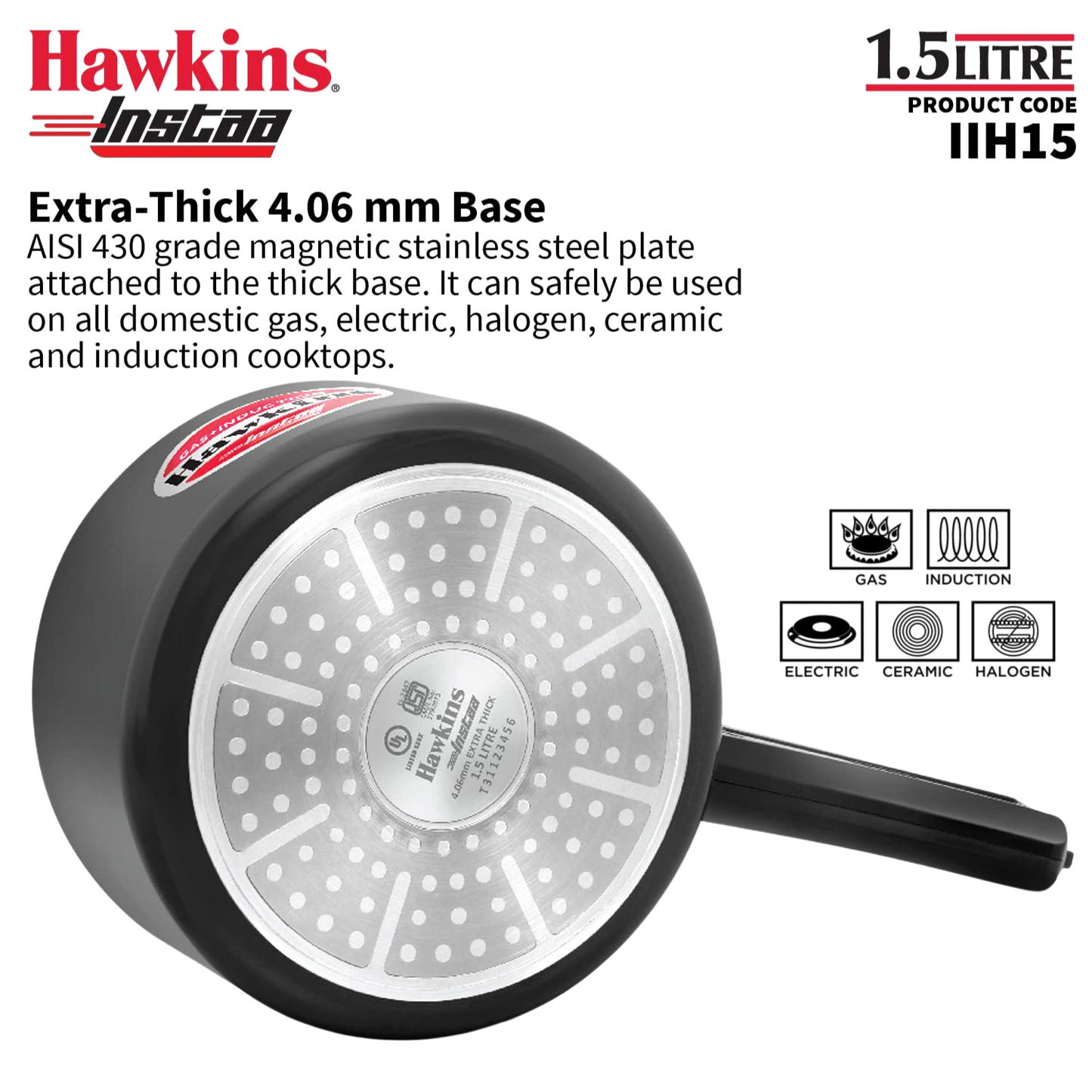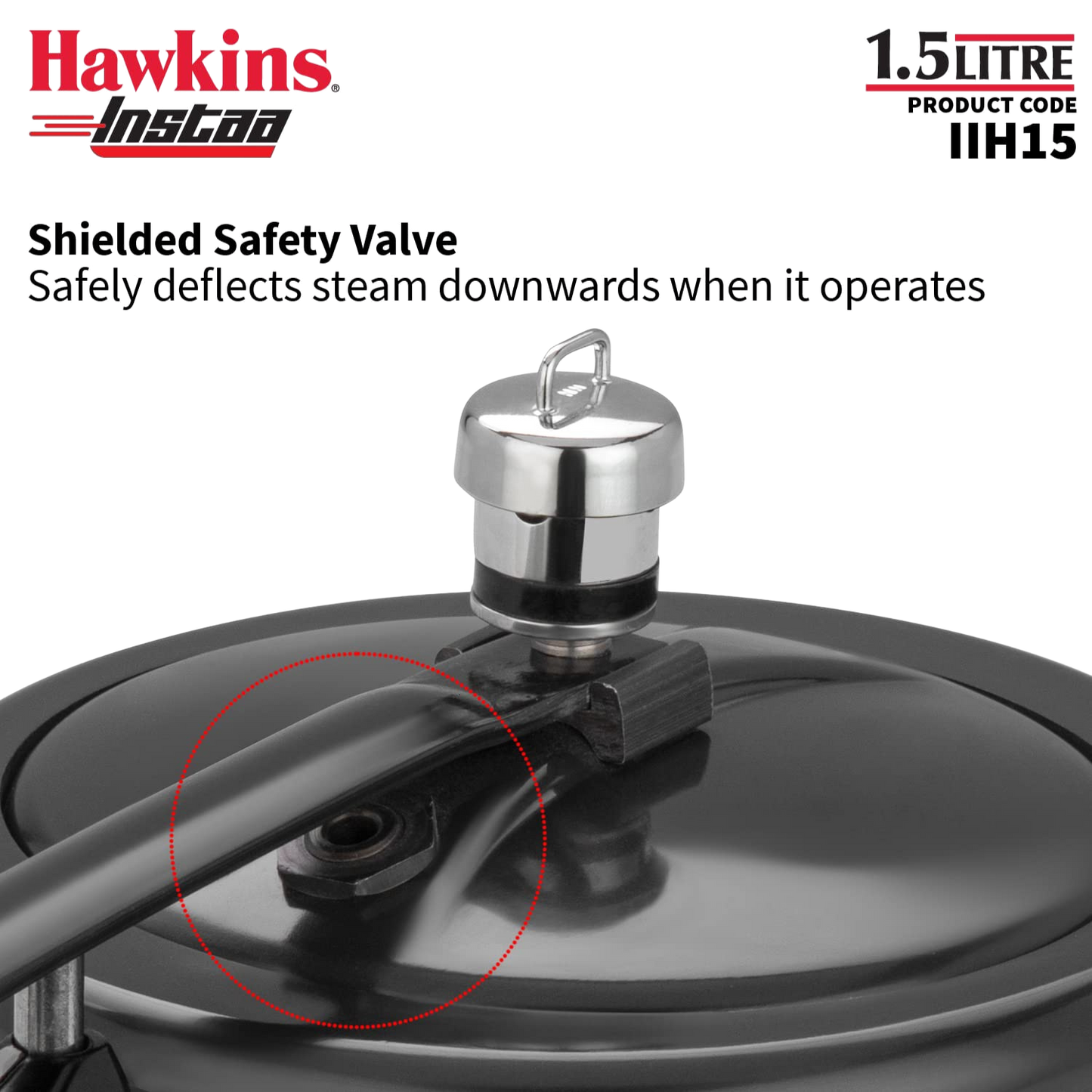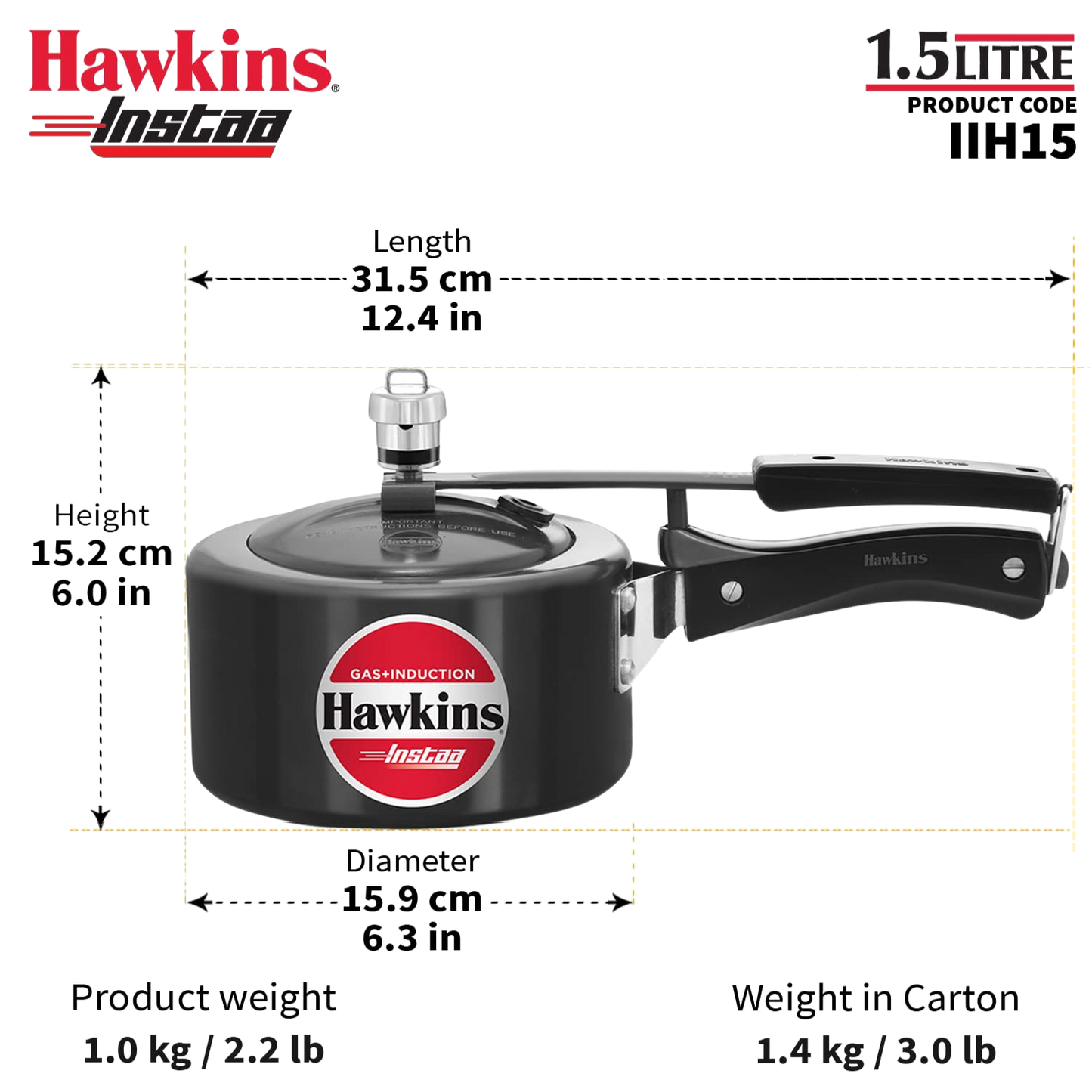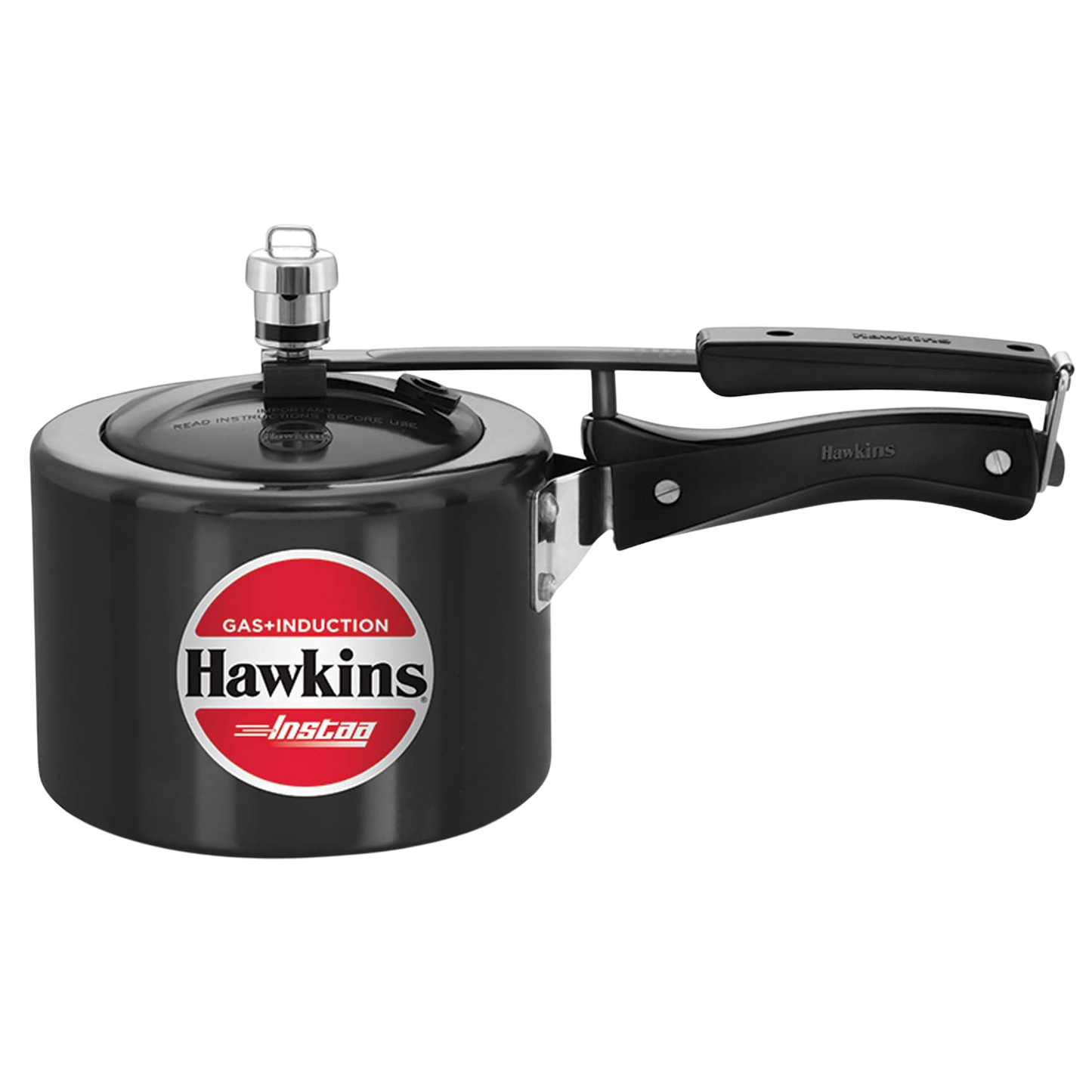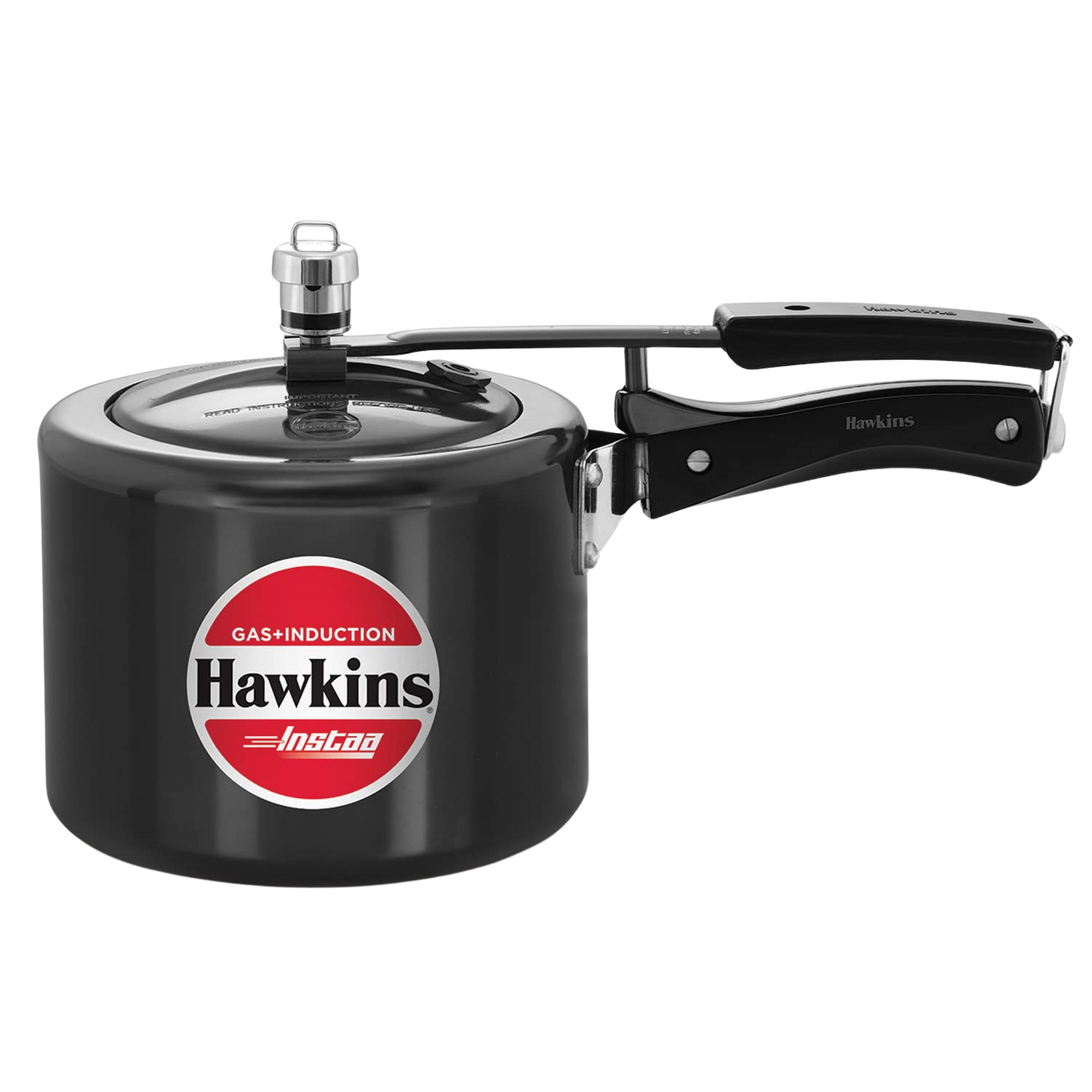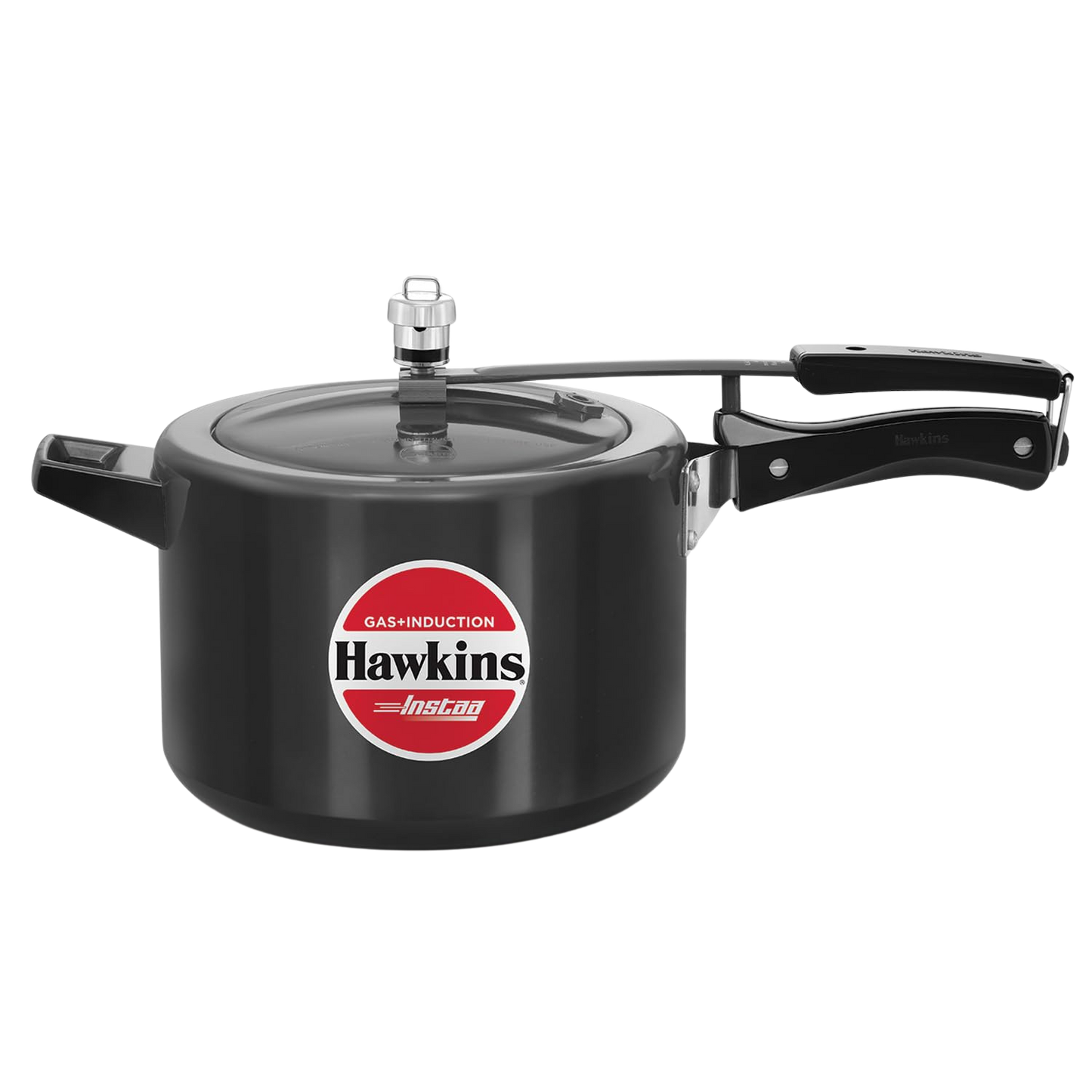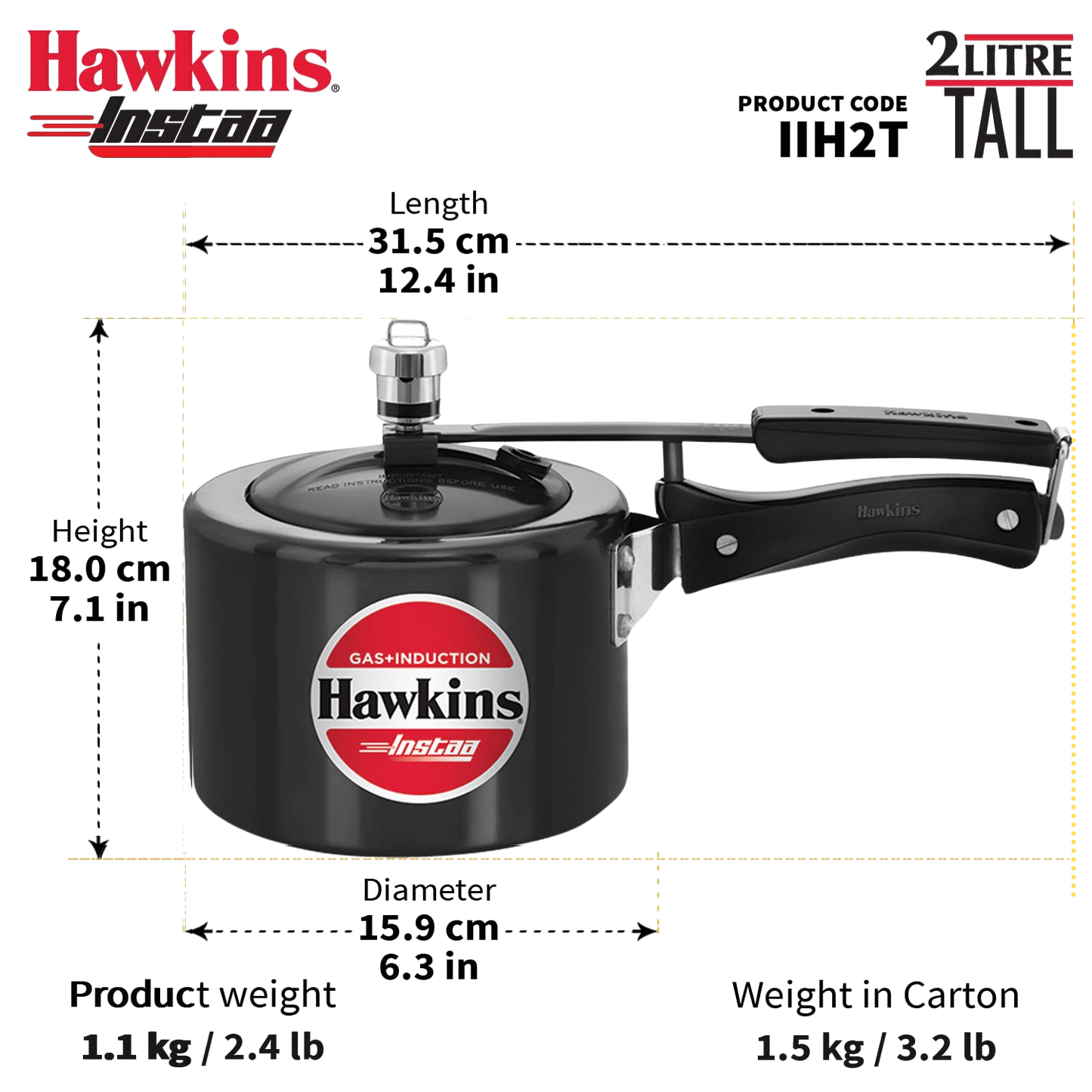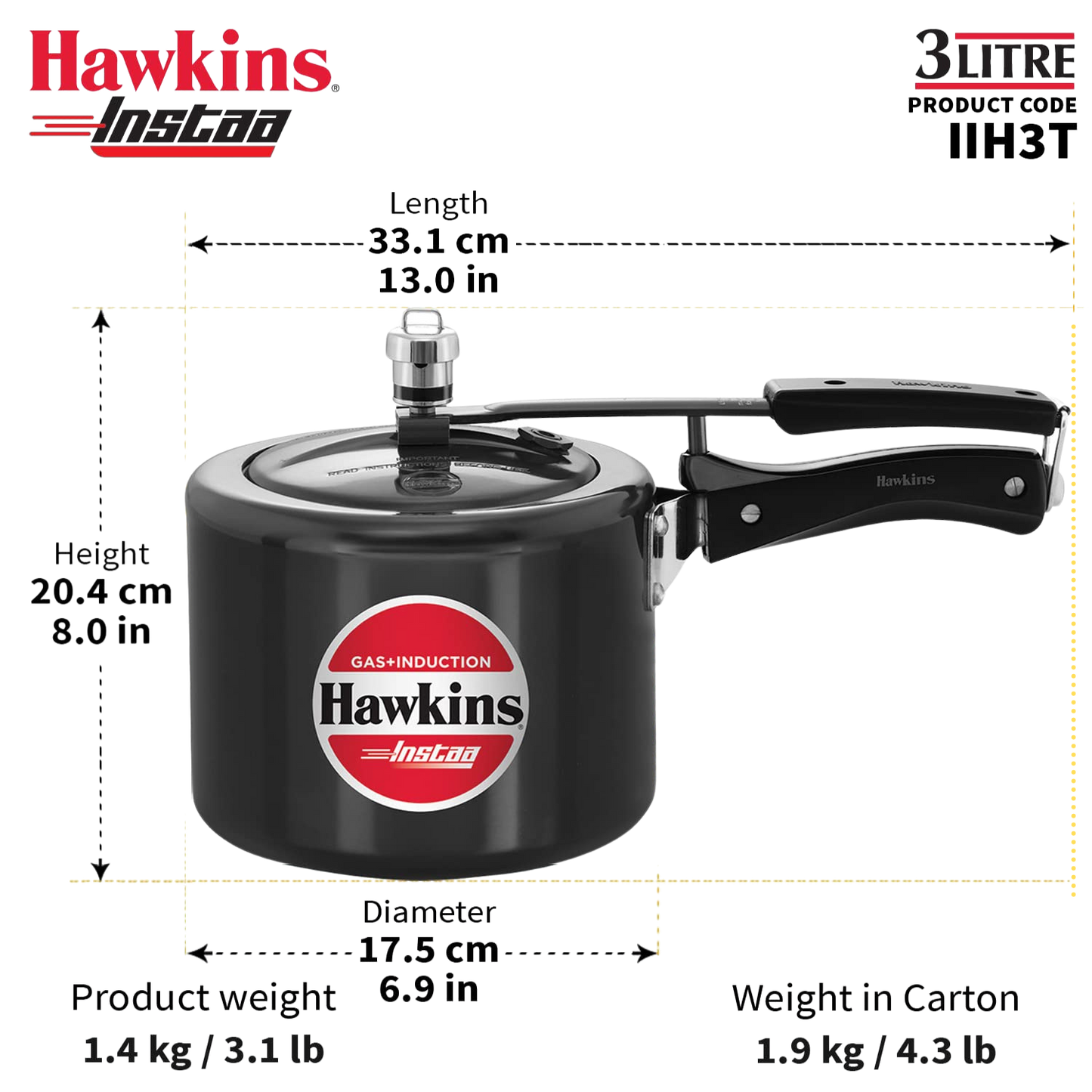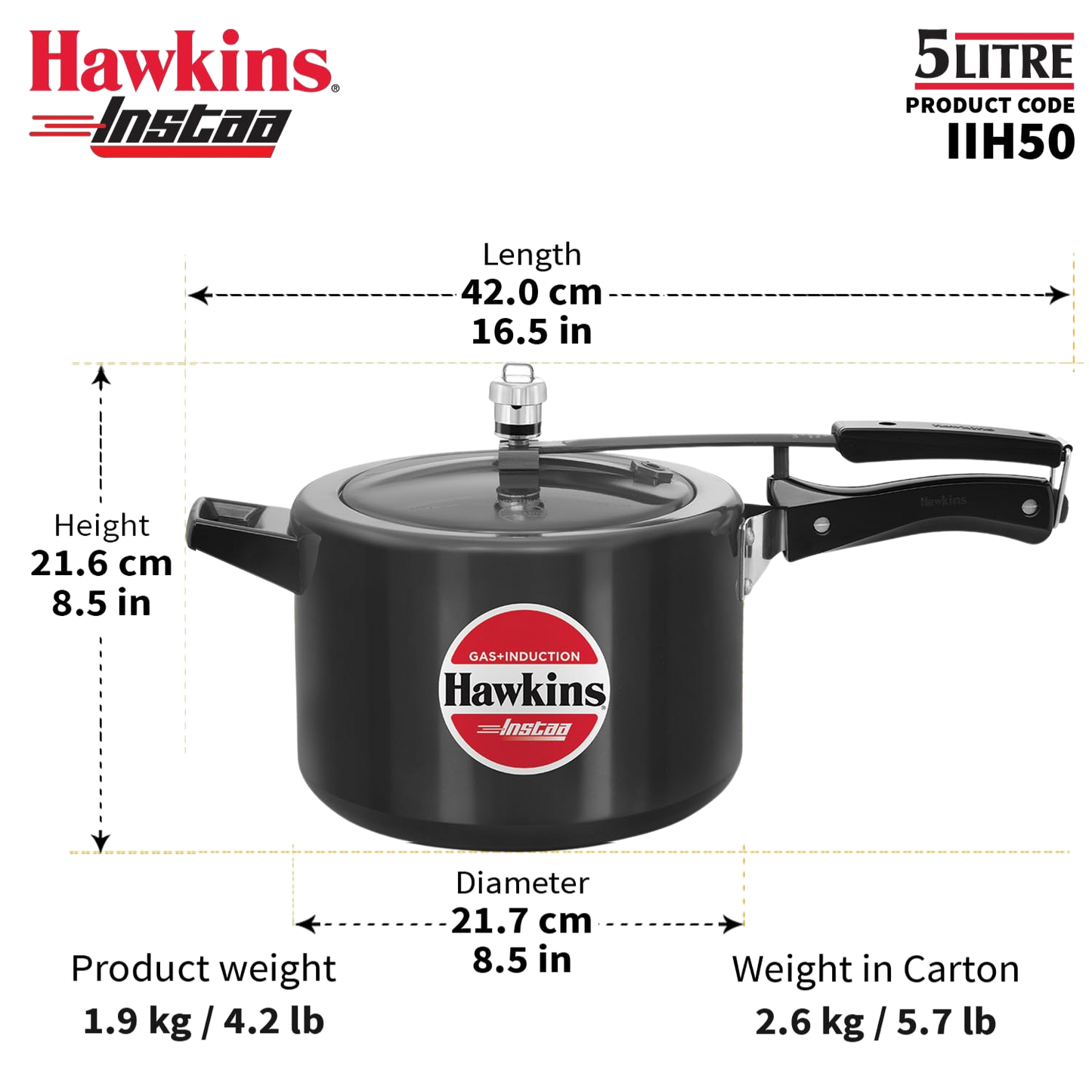HAWKINS Instaa Pressure Cooker, Induction Base Inner Lid Cooker | Hard Anodised Cooker | Black
HAWKINS Instaa Pressure Cooker, Induction Base Inner Lid Cooker | Hard Anodised Cooker | Black

About this item - 1.5 Ltr

From the Manufacturer/Importer
Hawkins Instaa Pressure Cooker is hard anodised inside and out rendering it non-toxic, hygienic, healthy and low-oil cooking. It does not pit or tarnish and stays looking new for years. It is not nonstick. It features 4.06 mm extra-thick induction base which stays flat always, heats evenly and food does not burn and stick. It works on Gas + Induction.
Each Hawkins Instaa features an inside-fitting lid. This design is inherently safer than conventional cookers. Thus Hawkins Instaa pressure cooker is pressure-locked for safety – like a jetliner door! It has a superior pressure regulating system that controls pressure to a narrower, more efficient range, reduces sprouting of frothy foods (such as dal) and is easier to insert and remove. The safety valve is located under the lid handle bar so that when it operates the steam is safely deflected downwards. The food-grade gasket has minimum exposure to steam inside the cooker, does not rub every time the product is opened and closed – so lasts longer. It has stay-cool handles. Fixed sturdy pivot does not put pressure on the plastic handles as it is a part of the metal handle itself. Thus handles last longer. "Play" or movement designed in the Lid Handle for perfect sealing & leak-free pressure cooking. Recommended for use on gas, electric, halogen, ceramic and induction cooktops.
|
Ideal for cooking for: |
1-2 Persons |
|
Base flat diameter: |
130 mm |
|
Base thickness: |
4.06 mm |
|
Carton dimensions (WxDxH): |
319 x 163 x 138 mm |
|
Product weight in carton: |
1.37 kg |
|
Net Quantity: |
1 U |

MANUFACTURED BY
HAWKINS COOKERS LIMITED
F 101, CUFFE PARADE
MUMBAI 400 005, INDIA.
Made in India
CONSUMERS: ANY QUESTIONS OR COMMENTS?
CONTACT:
HAWKINS SERVICE DEPARTMENT,
UDYOG MANDIR 2, MAHIM,
MUMBAI 400 016.
TEL: (022) 24 440 807
conserve@hawkinscookers.com
www.hawkinscookers.com
Disclaimer:
Actual product packaging and materials may contain more and different information than what is shown on our website. We recommend that you do not rely solely on the information presented and that you always read labels, warnings, and directions before using or consuming a product. Content on this site is for reference purposes.
Despite our attempts to provide you with the most accurate information possible, the actual packaging, ingredients, size, capacity and colour of the product may sometimes vary. Please read the label, directions and warnings carefully before use. Terms & Conditions apply. The product images are only for representation purpose. While every reasonable effort has been made to maintain accurate and up to date product related content, the product packaging, product size, weight, MRP and such other product details may differ from the actual product as may be delivered to you. Actual product packaging and materials may contain more and different information than what is shown on the website. The product information & media provided are shared as available in public domain or in the websites of the Manufacturers/Importers which neither owned nor endorsed by us. For more details contact Manufacturer/Importer.
Note:
Warranty, if any, not applicable on Breakable parts and normal wear & tear. Read Instruction manual before using the products for further details. Contact authorized service center for service. Retain warranty Card & proof of purchase to avail the warranty, if applicable. Contact customer support for service.
Legal Disclaimer: Warranty, if applicable, will be provided by the manufacturer/Importer through them or their nearest Authorized Service Centre.
General Disclaimer:
Please read our general information, Terms and conditions & policies carefully..
All Rights Reserved.
|
Care & Cleaning |
|
To get the best use from your Hawkins Pressure Cooker, observe the following directions. |
|
Body and Lid |
|
Remove label, wash, rinse and dry cooker before use. Remove any adhesive with baby or vegetable oil. |
|
Do not hit or knock the rim of the cooker body with a ladle, spoon or any other object and protect the edge of the lid from dents which may disturb sealing. |
|
Do not leave food or water in the cooker for hours. Do not leave the cooker lying in water or with dirty dishes. Chemicals and natural salts in the water and decomposing food can cause pitting of the metal. Do not leave salted liquid, vinegar, lemon juice, mayonnaise or mustard in the cooker. Never add salt to the cooker when there is no liquid in the cooker. |
|
Handles |
|
Plastic handles are liable to break under a blow. |
|
Do not attempt to remove the "play" or movement provided for the lid handle bar where it is attached to the lid. |
|
Rubber Sealing Ring/Gasket |
|
Do not stretch the sealing ring, particularly when it is hot, as it may distort. |
|
Replace the sealing ring when it no longer seals, becomes hard or cracked. Before replacing at the first sign of not sealing, however, check that the sealing ring is sitting flush in the lid curl and that the lid is properly centered. Sometimes just moving the sealing ring around or inverting it stops the leak. |
|
General Cleaning |
|
DO NOT WASH PRESSURE COOKER OR ANY OF ITS PARTS IN A DISHWASHER. The cooker body of the Hawkins Classic and the Hawkins Contura may be washed in a dishwasher but may tarnish. |
|
Always wash and dry every surface of the cooker soon after use. Food, if not removed, can corrode the metal over a period of time. |
|
Wash all parts of the cooker in hot water with a mild soap or detergent and a dishcloth or sponge. Rinse and wipe dry. Aluminium can become pitted if left wet. |
|
Carefully remove the sealing ring when washing the lid. Gently wipe or wash and rinse the sealing ring without stretching it. |
|
Check that the steam vent is clear after rinsing. If it is clogged, clean by carefully pushing a wire through the steam vent. Rinse with running water. A needle may be used to remove food from the steam vent nut. |
|
The pressure regulator can be cleaned with a jet of water to clear the holes inside. The colour of the black spring of the pressure regulator may wear off over time. This is normal wear and does not affect its functioning. |
|
Clean the area between the lid and the lid handle bar with a brush as required. (A special cleaning brush is supplied along with the Futura pressure cooker. The main brush is designed to clean between the handle and the lid. The shorter brush can be used to clean around the steam vent and the pressure regulator). |
|
Metallic marks - most often from gas stove pan supports - may appear on the black hard anodized base. To remove metallic marks from base: apply a kitchen cleanser to the marks and rub with an abrasive kitchen scrubber such as Scotch-Brite or fine steel wool. |
|
Baked-on Stains |
|
If the pressure cooker is not cleaned thoroughly after each use, a thin layer of food or grease may remain. When the cooker is heated next, this food/grease becomes "baked-on" and very difficult to remove. Avoid "baked-on" fat or gravy stains; wipe off any fat or gravy on the cooker base before placing on hot stove. Ensure stove surface in contact with pressure cooker is free of fat drippings. |
|
If you do get "baked-on" stains on the base, tackle them while they are still fresh. Soak in hot water. Make a thick paste of a chlorine-based kitchen cleanser and apply it to the surface. Wait 5 to 10 minutes, then scour with steel wool using a circular motion. Wash and wipe dry. |
|
If food is stuck to the cooker, remove with a plastic scrubber and a non-abrasive cleanser or an aluminium cleanser. If food is badly stuck or burned: pour into cooker enough water (not above half full) to cover the area of burned food. Close cooker. Bring to full pressure on high heat. Reduce heat and cook 5 minutes. Allow to cool naturally. Open cooker. Wash and wipe dry. Do not use abrasive powders or bleach. For stubborn spots, a fine soap-impregnated steel wool pad may be used sparingly, knowing that the cooker surface may get damaged. |
|
Loss of Shine |
|
With use, the aluminium cooker body and lid may lose their shine. The loss of shine is the normal behavior of the metal over time. |
|
Removing Stains Caused by Chemicals in the Water |
|
The inside of the cooker body may become darker due to minerals in the water. This darkening is neither injurious to health nor does it affect the taste and quality of food. To remove stains from inside the cooker body: fill cooker with water to half its capacity. Add 2 teaspoons tartaric acid (cream of tartar) or lemon juice for each quart/litre of water. Bring cooker to full pressure on high heat and cook 15 minutes. If you wish to remove stains from the upper half of the cooker body, do not pressure cook. Fill cooker with enough of the same water-tartaric acid solution to cover the stains. Boil 30 minutes. Wash and then dry with a soft, clean cloth. |
|
Storing |
|
Allow the cooker and all its parts to dry completely before storing. |
|
The sealing ring should be stored fitted in the lid curl. |
|
Store the cooker open to avoid mustiness. |
|
How to Prevent Unnecessary Fusing of the Safety Valve |
|
Check that the steam vent is clear by looking through it. |
|
Do not fill the cooker more than 2/3 (for liquid foods, not more than half). |
|
Do put enough water for the cooking time (See Easy Tips for Better Cooking ). |
|
Do not place the Hawkins pressure cooker (except the Big Boy) on an industrial burner or stove - use only a domestic stove. |
|
Do reduce heat to medium or lower when the pressure cooker reaches "Full Operating Pressure" (See Trial Run ). |
|
Do take the pressure cooker off the stove when its cooking time is complete (Check cooking time in our Pressure Cooking Charts or Recipes). |
|
Replaceable Parts |
|
Always use genuine Hawkins spare parts for your safety and the durability of the cooker. |
FAQs
1) Should you pressure-cook by counting whistles or timing as per the cookbook recipe?
|
Counting whistles may give you the wrong time for cooking any particular food or recipe. As a result, food may not get properly cooked, and there are chances of water drying up and food burning, and/or safety valve fusing. Start timing recipes when the pressure cooker reaches full operating pressure. Use a kitchen timer or watch/clock – precise timing is critical to successful pressure cooking, which is much faster than conventional cooking so timing errors have greater consequences. |
2) What is the maximum quantity of food that can be cooked in a pressure cooker?
|
Cooking capacity in a pressure cooker is less than its full volume. The pressure cooker body should never be filled more than two-thirds its capacity. This is to safeguard against blocking the steam vent/vent tube and to leave enough space to allow steam to circulate. Certain foods, however, such as soups and other liquid foods, foods such as lentils and rice which expand during cooking should not be loaded more than half the capacity of the cooker body. Dals which sprout, such as tuvar and moong, should not be loaded more than one-third the capacity of the cooker. |
3) Which foods cannot be cooked in a pressure cooker?
|
Certain foods, such as applesauce, cranberries, pearl barley, oatmeal or other cereals, split peas, noodles, macaroni, rhubarb or spaghetti can foam, froth and sputter, and clog the pressure release device (steam vent). These foods should not be cooked in a pressure cooker. Cooking moong dal is not recommended in pressure cookers of capacity 3 Litre or lesser, as it is prone to excessive frothing and sprouting. |
4) What is the minimum quantity of water that should be added while pressure cooking?
|
Minimum water recommendation is 1 cup/240 ml for the first 10 minutes of pressure cooking time and ½ cup for every subsequent 10 minutes or part thereof. It is important to follow the minimum water recommendation for pressure cooking because if there is less water there are chances of the cooker boiling dry. In such a situation, the temperature and pressure inside the cooker rise and cause the safety valve to fuse. |
5) Will the lid going inside the pot stop me from filling the cooker to capacity? Will the food soil the lid?
|
Every pressure cooker manufacturer recommends that the pressure cooker be filled no more than two thirds. This is because space is required for steam. What’s more, filling beyond a certain level increases the chance of food clogging the steam vent. Some pressure cookers such as the Futura and Hawkins Ventura have marked the maximum level to which food should be filled to make it easy for you to judge the required two-thirds level. The maximum quantities of food indicated are after allowing for this one-third empty space required in the cooker, which is the same for all cookers. You are therefore not losing any usable capacity by having an inside fitting lid. In fact, if you were to overfill the cooker by mistake the lid may not go in and that would remind you to reduce the food to the correct level. Here is an additional safety feature! |
6) Why is the lid handle of the pressure cooker loose?
|
There is some ‘play’ deliberately provided for the lid handle, as it assists in centralising the lid over the mouth of the cooker body and helps in proper sealing of the cooker. |
7) How do you prevent frothing and sprouting of dal in the pressure cooker?
|
1. Ensure that you use a small burner or medium heat of a large burner when cooking in a Baby series cooker. |
8) What are the reasons for fusing of safety valve?
|
1. If there is less water there are chances of the cooker boiling dry. In such a situation, the temperature and pressure inside the cooker rise and cause the safety valve to fuse. |
9) How do I replace a fused safety valve?
|
If the safety valve fuses, please shut the heat. When cool, replace the safety valve with a genuine Hawkins safety valve. Please see the section “Do-it-Yourself Repairs” at http://hawkinscookers.com/4.3.parts_and_service.html |
10) How do I replace a fused safety valve?
|
If the safety valve fuses, please shut the heat. When cool, replace the safety valve with a genuine Hawkins safety valve. Please see the section “Do-it-Yourself Repairs” at http://hawkinscookers.com/4.3.parts_and_service.html |
11) Does the Hawkins cooker have an ISI mark?
|
All Hawkins pressure cookers are quality-certified by the Bureau of Indian Standards, popularly known as ISI. Hence all pressure cookers manufactured by us carry the ISI stamp mark. Additionally, most of the Hawkins pressure cookers are listed by the Underwriters Laboratories, USA, an independent Worldwide institution testing products for public safety and carry UL stamp mark too. |
12) What is the pressure/temperature inside the Hawkins pressure cooker?
|
Pressure: 15 PSI (pounds per square inch); Temperature: 121ºC (250ºF) |
13) Can a pressure cooker be used for baking?
|
The pressure cooker should never be used as an oven for dry heating or baking as it reduces the strength of the metal & can damage the cooker. NO DRY HEATING ! |
Share
